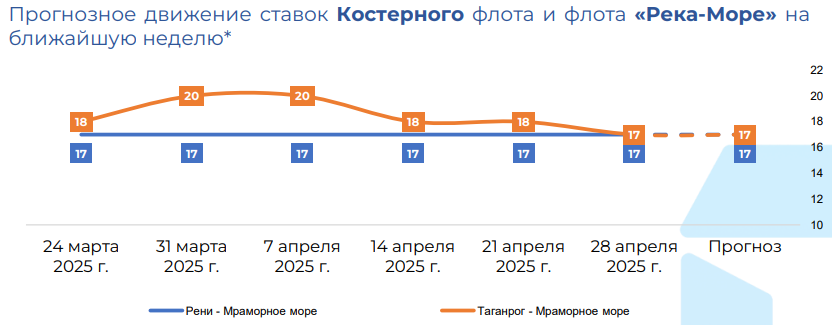The small-tonnage vessel market in the Black Sea remains in a depressed state. Despite the end of the Easter holidays, trading activity has not recovered. The number of available ships in the region continues to grow, adding pressure on freight rates, which are already at minimal levels. Most cargo inquiries involve grain, but demand for transportation remains weak. A notable indicator is the decline in rates for shipments from Ukrainian, EU, and Turkish ports, reflecting a clear imbalance between vessel supply and cargo volumes. Shipowners are trying to maintain rates at acceptable levels but are often forced to make concessions. A significant factor is the weak demand for Black Sea steel in Turkey, further reducing fleet utilization. The short-term outlook remains cautiously negative, as the shortage of export cargo and surplus of ships continue to weigh on the market.
In the Mediterranean Sea, the situation remains challenging with no clear signs of recovery. The number of ships consistently exceeds the available cargo, intensifying competition among shipowners. One of the few supporting factors for the market is the switch to more expensive fuel from May 1, prompting owners to lock in at least stable freight rates. However, weak demand for grain and construction cargo, along with moderate activity in the fertilizers and metals segment, prevents this strategy from being fully realized. Despite isolated deals for fertilizers and steel products, the overall trend in rates remains low. Many shipowners hope for improvement closer to summer, but at this point, there is no solid basis for increased activity. The outlook for the coming weeks suggests ongoing competition for cargo and continued pressure on freight rates.
In the Sea of Azov, the freight market remains under strain due to extremely low activity from grain exporters. Regular coal shipments provide some support for tonnage demand, but this is not enough to revive the market overall. The situation is especially difficult for vessels with a deadweight of 5,000 to 6,000 tons, whose owners are forced to accept increasingly lower rates. At the same time, smaller vessels are still able to maintain their positions thanks to stable niche cargo flows. Metallurgical cargo such as billet steel and coal shipments partly offset the lack of grain exports, but not enough to change the overall market balance. Given the ongoing weakness in wheat and pea exports, and the limited volume of new deals, the market in the Azov Sea remains highly unstable. A near-term recovery is unlikely, as high vessel availability and limited cargo supply will continue to put pressure on freight rates.

 +380 67 625 91 65
+380 67 625 91 65